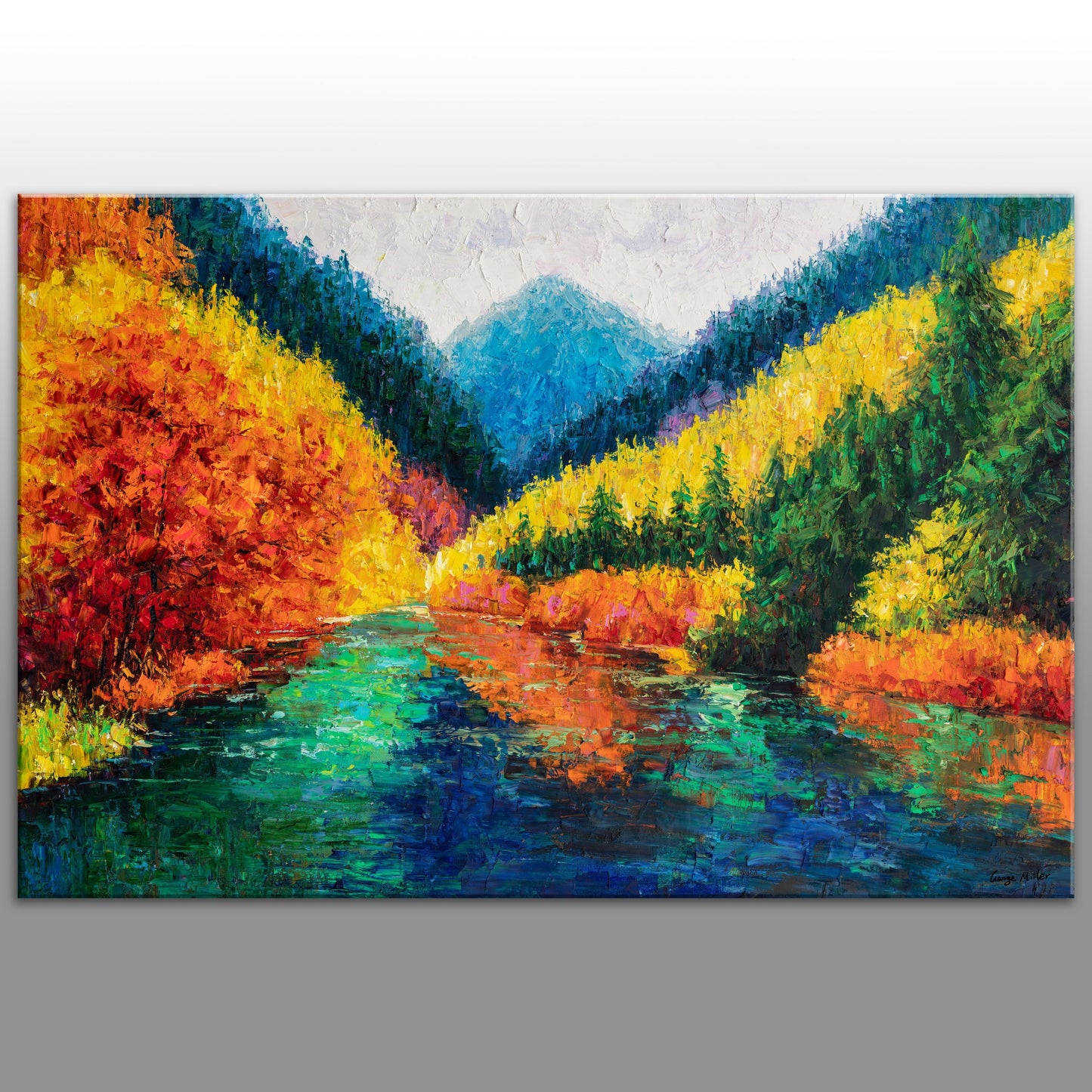Inspiring Design Inspirations with Oil Paintings for Sale
Exploring All Regarding Oil Paints: An Overview to Recognizing Their Charm and Value
Oil paintings have actually astounded audiences for centuries, providing a peek into the imaginative proficiency of numerous eras. Their rich history is linked with innovative strategies and profound psychological expression. Understanding the materials and approaches behind these art work can boost appreciation. Additionally, the marketplace for oil paints presents chances for collectors and capitalists alike. As one discovers this fascinating world, the question occurs: what makes an oil paint truly valuable?
The History of Oil Paint: A Journey Through Time
Although oil paint has origins that date back to ancient times, it absolutely flourished during the Renaissance, when artists uncovered its flexibility and rich color potential. Early instances can be mapped to the 7th century, with techniques progressing significantly across societies. The medium became popular in Northern Europe in the 15th century, especially with the works of musicians like Jan van Eyck, that originated its use for thorough realistic look and dynamic tones. This duration noted a departure from tempera paints, permitting higher depth and appearance. As oil paint spread, it affected plenty of artists, bring about work of arts by popular figures such as Leonardo da Vinci and Rembrandt. The medium's tradition continues, forming the art world well into modern-day times.
Recognizing Oil Repaints: Materials and Techniques
As musicians check out the world of oil paints, they experience a diverse array of materials and methods that define this tool. The main elements of oil paint include pigments, which provide color, and drying oils, such as linseed, that bind the pigments and help with application. Numerous additives can customize the paint's texture and drying time, improving convenience. Strategies like glazing, where clear layers are developed, and impasto, which involves applying thick paint, allow for different aesthetic effects. Furthermore, the usage of brushes, palette blades, and also fingers can create distinct structures and coatings. Comprehending these methods and materials allows artists to fully express their creativity and achieve the wanted influence in their art work.
The Function of Color in Oil Paintings
Shade plays a crucial function in oil paintings, affecting both aesthetic charm and emotional vibration. Comprehending color concept fundamentals, including the partnerships in between shades, can enhance a musician's ability to share mood and ambience. Furthermore, mastering shade mixing methods permits better depth and splendor in a painting's combination.

Shade Concept Essential
Comprehending shade theory is essential for musicians functioning with oil paints, as it develops the structure for creating aesthetically appealing and unified structures. Shade theory encompasses the study of just how shades engage, the color wheel, and the relationships between key, second, and tertiary shades. Artists use corresponding colors to enhance contrasts and develop centerpieces, while similar colors promote unity and cohesiveness within a piece. In addition, the ideas of warm and trendy colors affect the perception of deepness and space in a paint. Grasping these concepts enables musicians to manipulate shade efficiently, leading the audience's eye and connecting their intended message. Mastery of shade concept ultimately enhances a musician's capability to convey emotions and ideas with their work.
Psychological Impact of Shade
The psychological effect of color in oil paintings plays a crucial duty in how viewers view and attach with artwork. Colors evoke particular feelings and moods, affecting the viewer's mood. Cozy hues like oranges and reds can develop a feeling of heat and power, while great tones such as blues and environment-friendlies often evoke peace or self-questioning. Artists tactically pick shade schemes to enhance narrative elements, directing the audience's emotional journey. The saturation and comparison of colors further enhance these results, attracting attention and developing emphasis. Eventually, the interplay of shades in oil paints not only boosts their visual charm however additionally acts as a powerful medium for emotional expression, enriching the customer's experience and analysis.
Shade Combining Techniques
While lots of elements of oil paint add to the general make-up, mastering color blending methods is vital for attaining wanted impacts and depth. Color blending can be come close to via numerous approaches, consisting of the subtractive and additive procedures. Additive blending includes incorporating colors of light, while subtractive blending relies upon pigments, where shades mix to create brand-new shades. Artists often utilize a minimal scheme to produce unified jobs, recognizing the relationships in between primary, additional, and tertiary shades. Techniques such as glazing and scumbling additionally improve deepness and brightness. By skillfully blending shades, an artist can evoke feelings, produce centerpieces, and accomplish a sense of realism, eventually raising the painting's visual and psychological effect.
Famous Oil Painters and Their Iconic Functions

Famed for their mastery of color and technique, oil painters have developed a few of one of the most well known art work in history. Popular artists like Vincent van Gogh mesmerized target markets with his stirring brushwork in "Starry Night," while Claude Monet's "Impression, Daybreak" laid the foundation for Impressionism. Leonardo da Vinci's "Mona Lisa" stays an enduring icon of creative genius, showcasing his skill in catching human expression. Rembrandt's "The Night Watch" shows his innovative usage of light and shadow. Other more info remarkable figures include Pablo Picasso, who changed contemporary art with his vibrant testing in jobs like "Les Demoiselles d'Avignon," and Georgia O'Keeffe, whose dynamic representations of blossoms and landscapes helped define American innovation. Each artist's unique style contributed substantially to the oil painting landscape.
Just how to Examine the High Quality of an Oil Painting
Reviewing the high quality of an oil paint includes a careful analysis of workmanship techniques, along with an evaluation of color and make-up. Observing brushwork, layering, and the application of paint can expose the artist's ability level. In addition, the interplay of shades and the total arrangement of components contribute considerably to the painting's aesthetic worth.
Evaluating Craftsmanship Strategies
A careful assessment of workmanship methods is crucial for identifying the high quality of an oil paint. Evaluators need to initially analyze the application of paint; thick, distinctive brushstrokes may recommend a proficient hand, while excessively consistent applications could show a lack of depth. oil paintings for sale. The layering strategy is also essential; the presence of lusters and differed thickness can improve luminance and complexity. Furthermore, the quality of the materials utilized, such as the canvas and pigments, plays a significant function in resilience and general visual. Attention to detail in components like edges and shifts between colors mirrors the artist's dedication to their craft. Ultimately, these strategies add to the painting's emotional influence and market worth, functioning as indicators of the musician's ability and intent
Assessing Color and Composition
While examining the top quality of an oil paint, one must focus on the interaction of color and structure, as these aspects are fundamental to the artwork's total influence. Shade options can stimulate emotions and develop mood; therefore, the artist's palette should be analyzed for harmony and comparison. A healthy make-up directs the audience's eye and produces a sense of unity. Artists typically use techniques like the regulation of thirds or leading lines to enhance aesthetic interest. Additionally, using light and shadow can add depth, boosting the three-dimensionality of the painting. Ultimately, a successful oil paint marries color and composition, involving the viewer and welcoming a deeper recognition of the artist's vision and strategy.
Caring for and Preserving Oil Paintings
Appropriate treatment and preservation of oil paintings is crucial for keeping their honesty and durability. To secure these artworks, it is important to show them far from straight sunlight, which can create fading and staining. Keeping a stable setting with regulated temperature and moisture additional aids in stopping damage. Cleansing ought to be done gently utilizing a soft, completely dry towel, avoiding any extreme chemicals that could damage the paint or varnish. Routine assessments for indications of degeneration, such as fracturing or flaking, are suggested. When keeping or delivering oil paints, appropriate extra padding and framework are required to stay clear of physical injury. Ultimately, attentive treatment adds to the aesthetic appeal and worth of oil paints with time.
The Marketplace for Oil Paints: Gathering and Investing
Recognizing the market characteristics for oil paintings is necessary for capitalists and collection agencies alike. The value of these art work is influenced by various factors, including the artist's credibility, historical relevance, and current patterns. Collectors typically look for pieces that reverberate personally while thinking about potential admiration in value. Public auctions and galleries work as main locations for trading, with prices varying based upon demand and rarity. Investing in oil paints needs study into the market, along with an understanding of credibility and provenance. In addition, arising musicians may use chances for substantial returns, while developed names can regulate high prices. In general, a tactical method to collecting can generate both aesthetic pleasure and monetary benefits.

Regularly Asked Questions
What Are the Ecological Influences of Oil Paint Products?
The environmental influences of oil painting products consist of the launch of unstable natural compounds (VOCs), harmful waste generation, and resource removal for pigments. These variables add to contamination and ecological destruction, raising problems among environmentally mindful musicians and customers.
Exactly How Do Various Canvases Impact Oil Paint Results?
Various canvases influence oil paint results significantly. Structure, absorbency, and surface quality can change paint application, drying times, and shade vibrancy. Artists often choose certain canvases to achieve desired impacts and improve their creative expression.
Can Oil Paintings Be Brought Back if Harmed?
Oil paintings can undoubtedly be restored if harmed. Professional conservators utilize various strategies to repair tears, clean surface areas, and address staining, making sure that the artwork keeps its original appeal and value for future generations.
What Are the Indications of an Original Oil Paint?
The indicators of an original oil paint consist of visible brush strokes, appearance variants, and an uneven canvas weave (oil paintings for sale). Additionally, credibility might be verified through provenance, signatures, and the presence of a varnish layer one-of-a-kind to oil tools
Just How Has Innovation Influenced Modern Oil Paint Techniques?
Modern technology has significantly influenced modern-day oil paint methods by presenting electronic devices for preparation, boosted materials for structure and long life, and on the internet systems for sharing and marketing art, thus expanding musicians' innovative possibilities and target market get to. Oil paint has origins that date back to ancient times, it absolutely prospered throughout the Renaissance, when musicians discovered its flexibility and abundant color possibility. The psychological influence of color in oil paintings plays a vital duty in exactly how customers view and link with artwork. While lots of elements of oil paint contribute to the overall structure, understanding color mixing techniques is important for accomplishing wanted impacts and depth. Examining the top quality of an oil painting includes a cautious evaluation of craftsmanship methods, as well as an evaluation of color and structure. While reviewing the top quality of an oil painting, one need to focus on the interaction of shade and structure, as these aspects are basic to the artwork's overall influence.